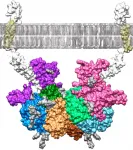INFORMATION:
Research to inform this article was funded by the External Environmental Economics Advisory Committee, with funding and support from the UCLA Luskin Center for Innovation and Alfred P. Sloan Foundation.
Co-authors for the paper include Sheila Olmstead, professor of public affairs at the University of Texas at Austin; David Keiser, associate professor of economics at the University of Massachusetts Amherst; Kevin Boyle, professor of agriculture and applied economics at Virginia Tech; Bonnie Keeler, assistant professor at the school of public affairs at the University of Minnesota; Catherin Kling, Tisch University Professor at the school of applied economics and management at Cornell University; Daniel Phaneuf, Henry C. Taylor Professor and Chair of agricultural and applied economics at the University of Wisconsin-Madison; Joseph Shapiro, associate professor at the University of California, Berkley and Jay Shimshack, associate dean and associate professor of public policy and economics at the University of Virginia.
Filling federal oversight gaps
Deregulated US Government oversight on interstate waters leaves murky implications for states
2021-04-20
(Press-News.org) The familiar murkiness of waters in the Gulf of Mexico can be off-putting for beachgoers visiting Galveston Island. Runoff from the Mississippi River makes its way to local beaches and causes downstream water to turn opaque and brown. Mud is one factor, and river runoff is another. However, concern tends to ratchet up a notch when pollution enters the river runoff discussion on a national scale, specifically when smaller, navigable intrastate bodies of water push pollution into larger interstate waters often involved in commerce (i.e. the Mississippi River, Great Lakes, Ohio River).
A recently published research analysis in the journal Science, co-authored by Victor Flatt, Dwight Olds Chair in Law at the University of Houston Law Center, demonstrates how the supposed benefits of retracting federal oversight on these transboundary waters and defaulting that responsibility to individual states failed to account for economic and scientific evidence that said otherwise and violated the bounds of justifiable law.
In the article, "A water rule that turns a blind eye to transboundary pollution," Flatt contributed as the sole legal researcher, explaining how the 2020 Navigable Waters Protection Rule, which retracted federal oversight of interstate waters, did so with the overt assumption that state governments would fill in the oversight gap. Not only did the evidence point toward an alternate outcome but the rule's federalism rationale was incorrect, according to the researchers.
"New administrations get to implement new policies, but those policies have to be consistent with statutes, the Constitution and be logical," Flatt said. "The legal phrase is: 'they cannot be arbitrary and capricious.' An administration can only do what is allowed by the law and must be rational and logical. This fails that. This is a policy disagreement, but it is a policy disagreement that is out of the bounds of what is allowed by law."
The cleanliness of larger transboundary rivers falls under the responsibility of the federal government and under the 2015 Clean Water Rule (CWR) enacted during former President Barack Obama's administration. This included small wetlands and streams that could push pollution runoff to these larger rivers that bisect several states. In 2020, under the Navigable Waters Protection Rule (NWPR), the federal regulation of some of those smaller, linked bodies of water was withdrawn, leaving individual states with the responsibility to fill in the gaps. However, many states did not assert control over these waters as assumed by former President Donald Trump's administration, leaving room for pollution to make its way to interstate waters.
"One prominent example is 31 states' challenge to the 2015 CWR in court, arguing that it would impose excessive costs. Inexplicably, the NWPR's economics analysis projected that 14 of these states would now change their position," according to the Science article. As Flatt explains, this assumption was the misstep.
"The Army Corps and EPA said in their analysis that 31 states will move into the breach and help protect the wetlands that the federal government would no longer protect," Flatt said. "But best practices for economic analysis state that you cannot speculate about future state actions. When I looked at this, I found a lot of these states are even prohibited from enacting a rule more stringent than the federal government. Here, the data is flawed."
In March, President Joe Biden's administration proposed a $111 billion investment in water infrastructure. Flatt said that the implementation of the investment will include review of previous policy and research, including information uncovered in the Science article.
ELSE PRESS RELEASES FROM THIS DATE:
Research brief: Improving rug efficacy against prostate cancer and related bone growths
2021-04-20
Published in the Advanced Functional Materials, University of Minnesota researcher Hongbo Pang led a cross-institutional study on improving the efficacy of nucleotide-based drugs against prostate cancer and bone metastasis.
In this study, Pang and his research team looked at whether liposomes, when integrated with the iRGD peptide, will help concentrate antisense oligonucleotides (ASOs) into primary prostate tumors and its bone metastases. Liposomes are used as a drug carrier system, and ASOs are a type of nucleotide drug.
More importantly, they investigated whether this system helps more drugs across the vessel wall and deeply into the tumor tissue. This is critical because, although nucleotide drugs offer unique advantages ...
'Dead clades walking': Fossil record provides new insights into mass extinctions
2021-04-20
Mass extinctions are known as times of global upheaval, causing rapid losses in biodiversity that wipe out entire animal groups. Some of the doomed groups linger on before going extinct, and a team of scientists found these "dead clades walking" (DCW) are more common and long-lasting than expected.
"Dead clades walking are a pattern in the fossil record where some animal groups make it past the extinction event, but they also can't succeed in the aftermath," said Benjamin Barnes, a doctoral student in geosciences at Penn State. "It paints the pictures of a group consigned to an eventual extinction."
The scientists found 70 of the 134 orders of ancient sea-dwelling invertebrates they examined could ...
Predicting the next pandemic virus is harder than we think
2021-04-20
The observation that most of the viruses that cause human disease come from other animals has led some researchers to attempt "zoonotic risk prediction" to second-guess the next virus to hit us. However, in an Essay publishing April 20th in the open access journal PLOS Biology, led by Dr Michelle Wille at the University of Sydney, Australia with co-authors Jemma Geoghegan and Edward Holmes, it is proposed that these zoonotic risk predictions are of limited value and will not tell us which virus will cause the next pandemic. Instead, we should target the human-animal interface for intensive viral surveillance.
So-called zoonotic viruses ...
Sexual receptivity and rejection may be orchestrated by the same brain region
2021-04-20
In many species, including humans and mice, the fluctuating levels of the hormones progesterone and estrogen determine whether the female is fertile or not. And in the case of mice, whether she's sexually receptive or not.
The change in receptivity is striking. Female mice shift from accepting sexual partners to aggressively rejecting them across a cycle of six short days. How can the female reproductive hormones bring about such a radical behavioural change?
When searching for an explanation, the team of Susana Lima, a principal investigator at the Champalimaud Centre for the Unknown in Portugal, came across an intriguing discovery.
"Our experiments revealed that a brain area important for female receptivity, called the VMH (ventromedial ...
'Undruggable' cancer protein becomes druggable, thanks to shrub
2021-04-20
A chemist from Purdue University has found a way to synthesize a compound to fight a previously "undruggable" cancer protein with benefits across a myriad of cancer types.
Inspired by a rare compound found in a shrub native to North America, Mingji Dai, professor of chemistry and a scientist at the Purdue University Center for Cancer Research, studied the compound and discovered a cost-effective and efficient way to synthesize it in the lab. The compound -- curcusone D -- has the potential to help combat a protein found in many cancers, including some forms of breast, brain, colorectal, prostate, lung and liver cancers, among others. The protein, dubbed BRAT1, had previously been deemed "undruggable" for its chemical properties. In collaboration with Alexander Adibekian's ...
Astronauts' mental health risks tested in the Antarctic
2021-04-20
Astronauts who spend extended time in space face stressors such as isolation, confinement, lack of privacy, altered light-dark cycles, monotony and separation from family. Interestingly, so do people who work at international research stations in Antarctica, where the extreme environment is characterized by numerous stressors that mirror those present during long-duration space exploration.
To better understand the psychological hurdles faced by astronauts, University of Houston professor of psychology Candice Alfano and her team developed the Mental Health Checklist (MHCL), a self-reporting instrument for detecting ...
Texas A&M study: Racial, ethnic diversity in schools influence mental health
2021-04-20
A Texas A&M researcher is discovering the demographic characteristics that can produce or lessen stress for racial and ethnic minority students in school settings.
The study, recently published in the journal Ethnicity and Disease, collected mental health survey assessments among 389 sixth-graders from 14 Texas public schools in urban areas. Melissa DuPont-Reyes, assistant professor at the Texas A&M University School of Public Health, led the investigation of self-reported depressive-anxious symptoms over a two-year period. This issue of the journal highlighted research by early stage investigators, especially scholars of color, to advance new knowledge ...
Marine animals inspire new approaches to structural topology optimization
2021-04-20
A mollusk and shrimp are two unlikely marine animals that are playing a very important role in engineering. The bodies of both animals illustrate how natural features, like the structures of their bones and shells, can be borrowed to enhance the performance of engineered structures and materials, like bridges and airplanes. This phenomenon, known as biomimetics, is helping advance structural topology research, where the microscale features found in natural systems are being mimicked.
In a recent paper published by researchers at the Georgia Institute of Technology and the Pontifical Catholic University of Rio de ...
Boosting fiber optics communications with advanced quantum-enhanced receiver
2021-04-20
WASHINGTON, April 20, 2021 -- Fiber optic technology is the holy grail of high-speed, long-distance telecommunications. Still, with the continuing exponential growth of internet traffic, researchers are warning of a capacity crunch.
In AVS Quantum Science, by AIP Publishing, researchers from the National Institute of Standards and Technology and the University of Maryland show how quantum-enhanced receivers could play a critical role in addressing this challenge.
The scientists developed a method to enhance receivers based on quantum physics properties to dramatically increase network ...
Inhibition of meprin β enzyme linked to the development of Alzheimer's disease analyzed
2021-04-20
Researchers at Johannes Gutenberg University Mainz (JGU) in Germany and the Institute of Molecular Biology of Barcelona in Spain have discovered how the blood plasma protein fetuin-B binds to the enzyme meprin β and used a computer model to visualize their findings. These results could lead to the development of new drugs to treat serious diseases such as Alzheimer's and cancer. Meprin β releases proteins from cell membranes, thus controlling important physiological functions in the human body. However, a dysregulation of this process can trigger the development of Alzheimer's and ...
LAST 30 PRESS RELEASES:
Making lighter work of calculating fluid and heat flow
Normalizing blood sugar can halve heart attack risk
Lowering blood sugar cuts heart attack risk in people with prediabetes
Study links genetic variants to risk of blinding eye disease in premature infants
Non-opioid ‘pain sponge’ therapy halts cartilage degeneration and relieves chronic pain
AI can pick up cultural values by mimicking how kids learn
China’s ecological redlines offer fast track to 30 x 30 global conservation goal
Invisible indoor threats: emerging household contaminants and their growing risks to human health
Adding antibody treatment to chemo boosts outcomes for children with rare cancer
Germline pathogenic variants among women without a history of breast cancer
Tanning beds triple melanoma risk, potentially causing broad DNA damage
Unique bond identified as key to viral infection speed
Indoor tanning makes youthful skin much older on a genetic level
Mouse model sheds new light on the causes and potential solutions to human GI problems linked to muscular dystrophy
The Journal of Nuclear Medicine ahead-of-print tip sheet: December 12, 2025
Smarter tools for peering into the microscopic world
Applications open for funding to conduct research in the Kinsey Institute archives
Global measure underestimates the severity of food insecurity
Child survivors of critical illness are missing out on timely follow up care
Risk-based vs annual breast cancer screening / the WISDOM randomized clinical trial
University of Toronto launches Electric Vehicle Innovation Ontario to accelerate advanced EV technologies and build Canada’s innovation advantage
Early relapse predicts poor outcomes in aggressive blood cancer
American College of Lifestyle Medicine applauds two CMS models aligned with lifestyle medicine practice and reimbursement
Clinical trial finds cannabis use not a barrier to quitting nicotine vaping
Supplemental nutrition assistance program policies and food insecurity
Switching immune cells to “night mode” could limit damage after a heart attack, study suggests
URI-based Global RIghts Project report spotlights continued troubling trends in worldwide inhumane treatment
Neutrophils are less aggressive at night, explaining why nighttime heart attacks cause less damage than daytime events
Menopausal hormone therapy may not pose breast cancer risk for women with BRCA mutations
Mobile health tool may improve quality of life for adolescent and young adult breast cancer survivors
[Press-News.org] Filling federal oversight gapsDeregulated US Government oversight on interstate waters leaves murky implications for states








